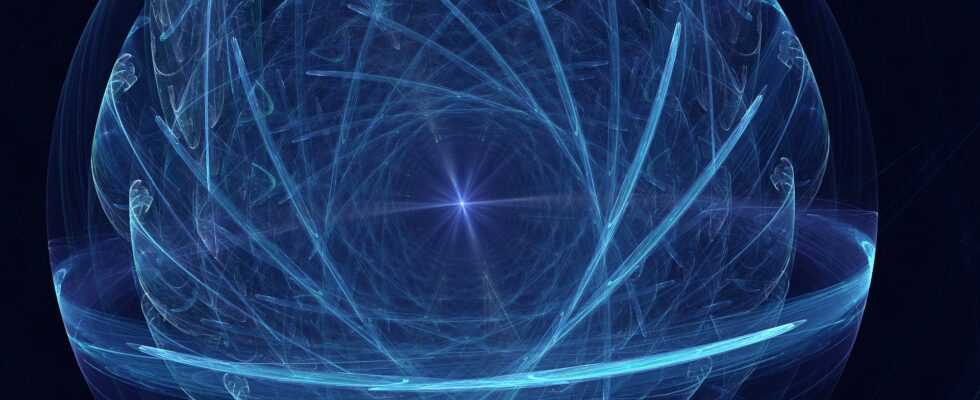© Nobi_Prizue / Getty Images / iStock (detail)
Holographic | Perhaps links create space like a 2-D structure creates a 3-D image.
However, string theory is not the only approach to emergent spacetime. According to Abhay Ashtekar of Pennsylvania State University in University Park, “it has not lived up to its promise of uniting gravity and quantum mechanics. The strength of string theory now lies in its extremely rich toolkit, which is widely used across the entire spectrum of physics.« Ashtekar is one of the founders of the most popular alternative to string theory, the so-called loop quantum gravity. There, space and time are not smooth and continuous as in general relativity, but consist of discrete components. Ashtekar calls them “bits or atoms of space-time.”
These are connected to form a network and span a so-called spin foam using one- and two-dimensional threads and ribbons. Although the foam is limited to two dimensions, this results in our four-dimensional world. Ashtekar illustrates the situation with a piece of clothing: »If you look at your shirt, it looks like a two-dimensional surface. Under a magnifying glass you can see that it is made up of one-dimensional threads. But because they’re so densely packed, for all practical purposes, the shirt is two-dimensional. Correspondingly, space appears to us as a three-dimensional continuum, which is in fact woven by the atoms of space-time.«
Although spacetime is said to be emergent in both string theory and loop quantum gravity, the nature of emergence differs in the two theories. According to string theory, space-time, or at least space, emerges from the behavior of an apparently completely detached system of entanglements, a little like road traffic with occasional traffic jams emerges from the collective decisions of individual drivers. The cars are not made of traffic, they create it themselves. In loop quantum gravity, on the other hand, space-time is more like a dune landscape sculpted by the combined movement of sand grains in the wind. The dunes are made of the same stuff, although they don’t look or act like the tiny grains.
Despite such differences, spacetime arises from more fundamental components in both loop quantum gravity and string theory. Other models of quantum gravity also point in this direction, such as the »Causal Sets« (see »Many Approaches to Quantum Gravity«). “It’s really striking that most plausible theories today imply, in some way, that the space-time from general relativity doesn’t exist anymore at the fundamental level,” Knox notes. “So the different approaches seem to agree on at least one thing. Just the thought is exciting.«
A lack of experimental data complicates the search for quantum gravity
Modern physics has become a victim of its own success. Both quantum physics and general relativity make phenomenally accurate predictions within their respective domains. For this reason, quantum gravity is only needed as a description in extreme situations, in which enormous masses are compressed into unimaginably tiny areas of space. In nature, such conditions only occur in a few places, such as at the center of a black hole. In particular, they are not encountered in physics labs, even the largest and most powerful. This lack of direct experimental data is a major reason why the search for a theory of quantum gravity has been going on for so long.
Given this, many are pinning their hopes on a glimpse of heaven. During its very first moments, the entire universe was unimaginably small and dense. The situation can only be described in terms of quantum gravity, and repercussions of that may still be seen. “Our best chances are in cosmology,” hopes Maldacena. “Perhaps there is something there that we cannot predict today, but that can be deduced based on a better theoretical understanding.”
Laboratory experiments could still prove useful, at least indirectly. For example, a working group led by Monika Schleier-Smith from Stanford University wants to investigate aspects of the AdS/CFT correspondence using atoms in highly entangled quantum systems (see »Spectrum« February 2022, p. 64). The behavior of parts of the experimental set-up might then be reminiscent of space-time. Such experiments could “show some, but perhaps not all, of the features of gravity,” says Maldacena. “It also depends on what exactly you call gravity.”
Will we ever learn the true nature of space and time? Appropriate cosmological observation data may be a long time coming. Laboratory tests could still give nothing. And as philosophers know only too well, questions about the nature of space and time are very old. 2500 years ago Parmenides understood beings as indivisible and unchangeable. According to him, change is an illusion. His student Zeno famously created paradoxes to prove his teacher’s point and to show the inconsistencies that should be inherent in movements. Such works have raised the question of whether time and space are imaginary and have imprinted this disturbing perspective on Western philosophy. “The fact that the ancient Greeks asked questions about space, time and change and that we still do that today means that they were the right ones,” says Christian Wüthrich. “Thinking about it taught us a lot about physics.”
